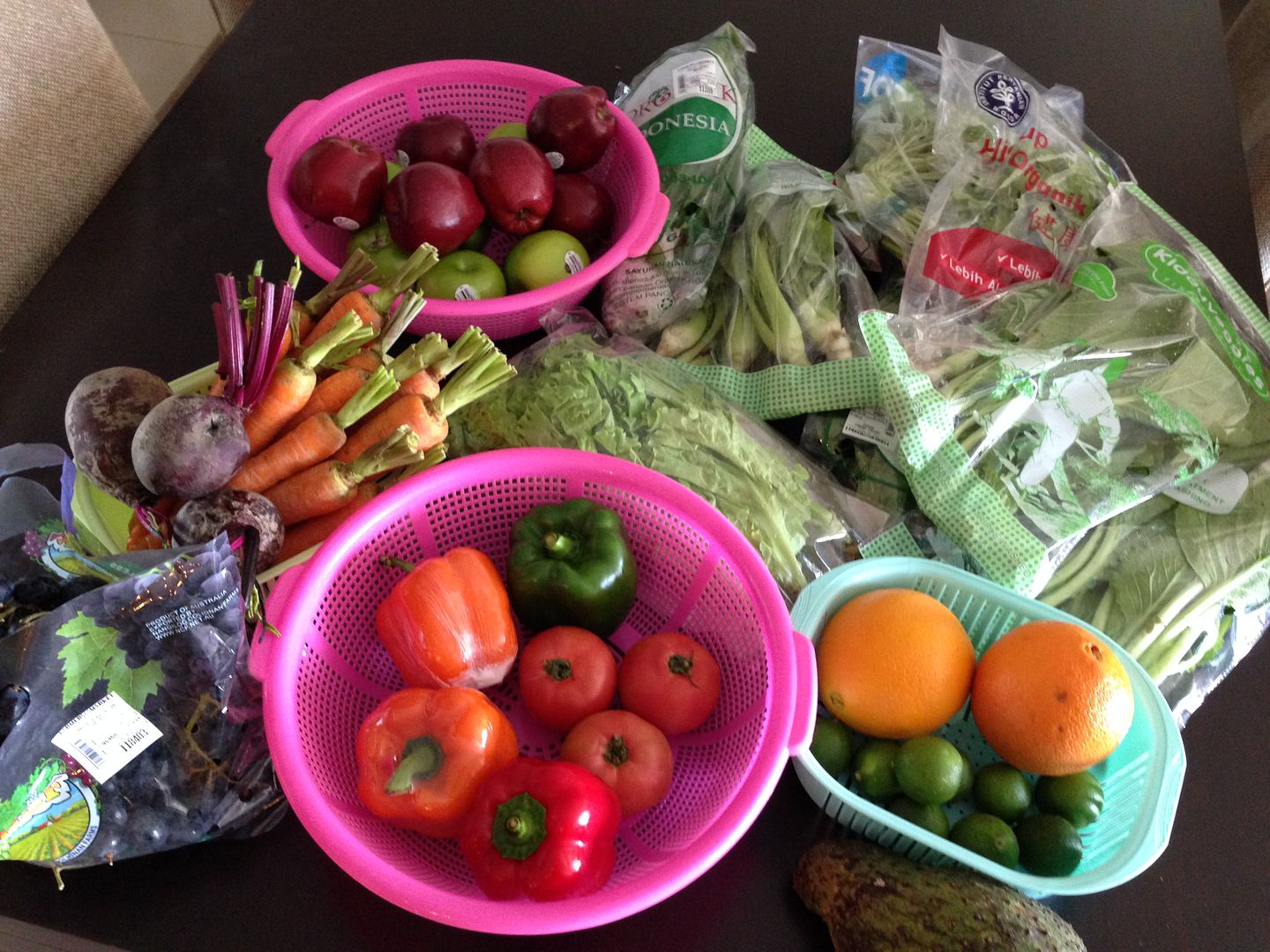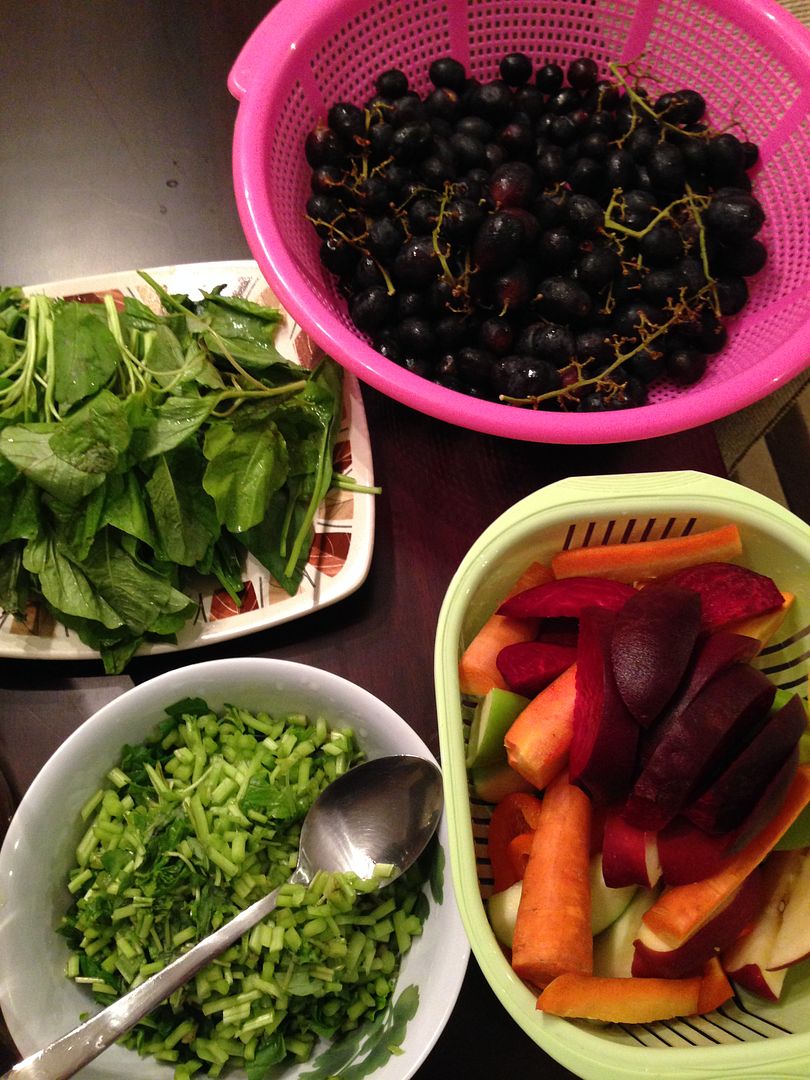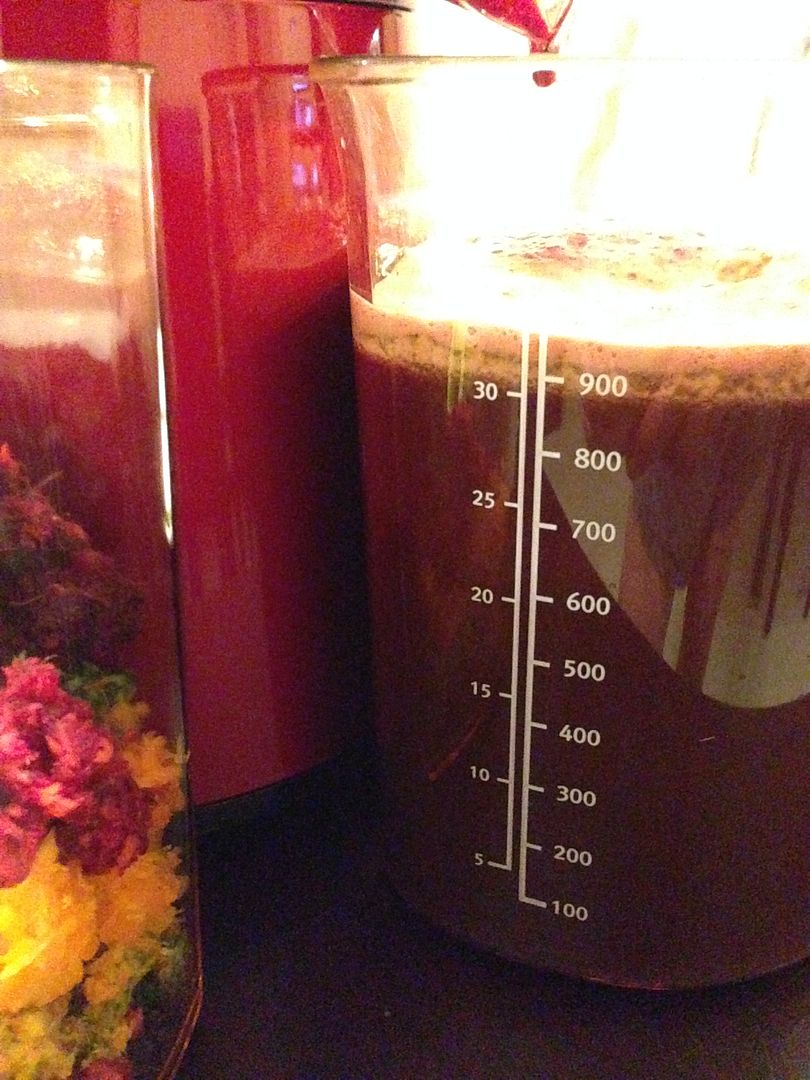In case people are unaware there are different varieties of carrots available. At Natures Glory they have purple & the normal orange colored carrots. Recently they brought in yellow carrots.
The different colors show the difference in the pigmentation. It always healthier to juice a rainbow of colors instead of just limiting to a single type e.g. green
http://www.ars.usda.gov/is/pr/2004/041115.htm
http://www.ars.usda.gov/is/AR/archive/nov04/carrot1104.htm
New Carrots Offer Colorful Surprises--and Health Benefits
By Erin Peabody
November 15, 2004
Researchers with the Agricultural Research Service may have found the best way to entice consumers to eat their veggies: Surprise them. They're breeding carrots that come in a palette of totally unexpected colors including yellow, dark orange, bright red--even purple.
With their flashy colors, these conventionally-bred carrots could dress up any dull meal. But what's getting scientists' attention is finding that the bright veggies are full of pigments with impressive health-promoting properties.
Xanthophylls give the yellow carrots their golden hues and have been linked with good eye health. Red carrots contain lycopene, a type of carotene also found in tomatoes that's believed to guard against heart disease and some cancers.
Purple carrots owe their color to anthocyanins. In a class all by themselves, these pigments are considered to be powerful antioxidants that can guard the body's fragile cells from the destructive effects of unstable molecules known as free radicals.
At first, Philipp Simon--the carrots' breeder who works at the ARS Vegetable Crops Research Unit in Madison, Wis.--was unsure if these complex vegetables could provide nutrients in a form that the human body can use.
But in studies with nutritionist Sherry Tanumihardjo from the University of Wisconsin in Madison, Simon found that yellow carrots' lutein was 65 percent as bioavailable as it is from a lutein supplement. The two also discovered that lycopene from red-pigmented carrots is 40 percent as bioavailable as it is from tomato paste.
And for consumers who don't like tomatoes, having another food source of lycopene would be good news.
Despite their nutritional and culinary appeal, Simon's carrots haven't yet caught on in growers' circles. But that could change as consumers create a demand for these strange, but good-for-you veggies.
Read more about the carrots in the November issue of Agricultural Research magazine.
ARS is the chief scientific research agency of the U.S. Department of Agriculture. This research was funded in part by the Initiative for Future Agriculture and Food Systems, a program of USDA's Cooperative State Research, Education and Extension Service.
Carrots With Character
.
Shredded in salads and slaws, steamed, or just peeled and dunked in an herb-speckled dip, carrots are versatile veggies that add colorful zest to our dinner plates. These crunchy orange roots are also a well-known source of vitamin A. Just a single, full-size carrot more than fulfills an adult's daily quotient of the essential vitamin.
But the carrot hasn't always been the vitamin A powerhouse that it is today. Over two decades ago, scientists in the ARS Vegetable Crops Research Unit at Madison, Wisconsin, began a quest to breed carrots packed with beta-carotene—an orange pigment used by the body to create vitamin A. Thanks largely to this ARS work, today's carrots provide consumers with 75 percent more beta-carotene than those available 25 years ago.
Cross-sections of highly pigmented carrots: Click here for photo caption.
Cross-sections of the
highly pigmented carrots.
(K11611-2)
The researchers, led by plant geneticist Philipp Simon, haven't limited themselves to the color orange. They've selectively bred a rainbow of carrots—purple, red, yellow, even white. Scientists are learning that these plant pigments perform a range of protective duties in the human body—which is not surprising, says Simon, since many of the pigments serve to shield plant cells during photosynthesis.
Red carrots derive their color mainly from lycopene, a type of carotene believed to guard against heart disease and some cancers. Yellow carrots accumulate xanthophylls, pigments similar to beta-carotene that support good eye health. Purple carrots possess an entirely different class of pigments—anthocyanins—which act as powerful antioxidants.
While colored carrots are unusual, they're not exactly new. "Purple and yellow carrots were eaten more than 1,000 years ago in Afghanistan and 700 years ago in western Europe," says Simon. "But the carrot-breeding process has gone on intensively for just 50 years."
Simon and his team of ARS researchers and colleagues at the University of Wisconsin-Madison (UW) have recently shown that their highly pigmented carrots are a ready source of some sought-after nutrients.
The Eyes Have It
Lutein is one of the hydroxy carotenoids that make up the macular pigment of human retinas. Consuming foods high in lutein may increase the density of this pigment and decrease the risk for developing macular degeneration, an age-related disease.
"Up to now," says Simon, "we didn't know whether lutein was biologically available from carrots, because they're considered a complex food."
In a study to determine humans' lutein uptake from lutein-rich yellow carrots, Simon, along with UW's Sherry Tanumihardjo, recruited nine 23- to 28-year-old volunteers to eat the carrots and take a lutein supplement. By reading the participants' blood serum levels, the researchers found that lutein from the carrots was 65 percent as bioavailable as it was from the supplement.
Tanumihardjo, an assistant professor in UW's Department of Nutritional Sciences, says, "While other foods might contain higher levels of lutein—like spinach for instance—lutein is absorbed very well from lutein-rich carrots."
In another study, Simon and Tanumihardjo found that lycopene from red-pigmented carrots is 40 percent as bioavailable as it is from tomato paste. "Not everyone eats or likes tomatoes," she says, "so finding another source of lycopene that also provides beta-carotene is very positive."
Their lycopene study appeared in the May 2004 issue of the European Journal of Clinical Nutrition. The lutein study appeared in the July 2004 issue of the American Journal of Clinical Nutrition.
Behind the Colors
In nature, different strains of carrots contain varying types and amounts of carotenoids—the pigments responsible for orange, yellow, and red colors. To assist seed companies and growers who wish to produce nutrient-rich carrots, Simon and his lab are working to map all the genes that play a part in synthesizing carotenoids in major carrot lines. Simon now knows of 20 genes that are involved. But determining a particular gene's role in generating carotenoids is not that straightforward.
"There are complexities in reading these genes," he says, "since their functions often change with the plant as it progresses through its life cycle." From Simon's work, it appears that two or three major genes account for differences in white and orange carrots and that another couple of genes separate yellow carrots from red.
Why Be Conventional?
What would you say to a glass of purple carrot juice? Some aren't so sure.
Aside from enhancing the nutritional value of carrots—as well as onions, garlic, and cucumbers—researchers at Simon's laboratory also work to improve the veggies' culinary quality and appeal.
"It's hard to know what to aim for when selecting for a purple carrot," Simon says, "since we've no defined type to go by." So he's subjecting the new varieties to consumer taste tests, hoping to find carrots with a sweet and mild flavor.
"People who are asked to taste the colorful carrots are concerned about their flavor," says Simon. "We've become married to the colors we associate with particular foods. We eat with our eyes, to some extent."
Tanumihardjo agrees. "I did a study to find out whether carrot color prompted perception of taste at all," she says. "When people were able to see the color of the carrot—whether it was purple or red—they responded more favorably to it."
With the help of Tanumihardjo, Simon is tapping taste preferences through an unexpected group of eaters: children in Wisconsin's inner cities and American Indian reservations. Children from lower income groups are at greater risk for developing a nutritional deficiency, like low vitamin A status. "Some of these kids have never even had a carrot before," says Simon. But their comments so far have been positive, according to Tanumihardjo.
With their compelling health benefits and a thumbs-up from taste testers, Simon's colorful carrots will be a great addition to supermarket produce aisles once consumers create a demand for them.—By Erin K. Peabody, formerly with Agricultural Research Service Information Staff.
This research is part of Plant, Microbial, and Insect Genetic Resistance, Genomics, and Genetic Improvement, an ARS National Program (#301) described on the World Wide Web at
www.nps.ars.usda.gov.
Philipp W. Simon is in the USDA-ARS Vegetable Crops Research Unit, 1575 Linden Dr., Madison, WI 53706; phone (608) 262-1248, fax (608) 262-4743.
"Carrots With Character" was published in the November 2004 issue of Agricultural Research magazine.

 There are different levels of organic. There are the locally grown stuff which are grown without using chemicals. These are probably grown by using hydroponics. The more expensive organic produce is imported from places like Australia, NZ, US,... The reason I go with Australian organic produce is because the soil & environment is more pristine.
There are different levels of organic. There are the locally grown stuff which are grown without using chemicals. These are probably grown by using hydroponics. The more expensive organic produce is imported from places like Australia, NZ, US,... The reason I go with Australian organic produce is because the soil & environment is more pristine.


